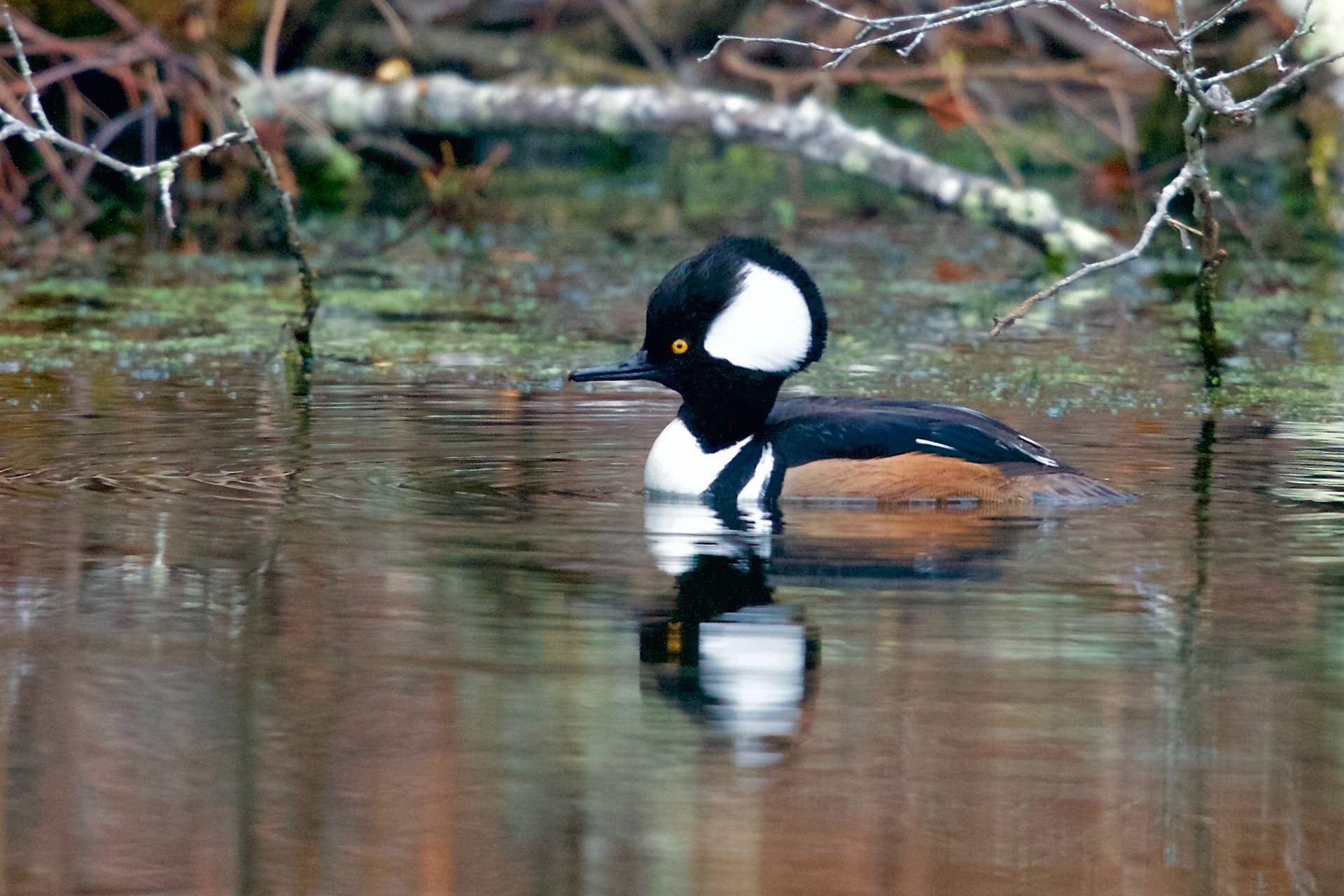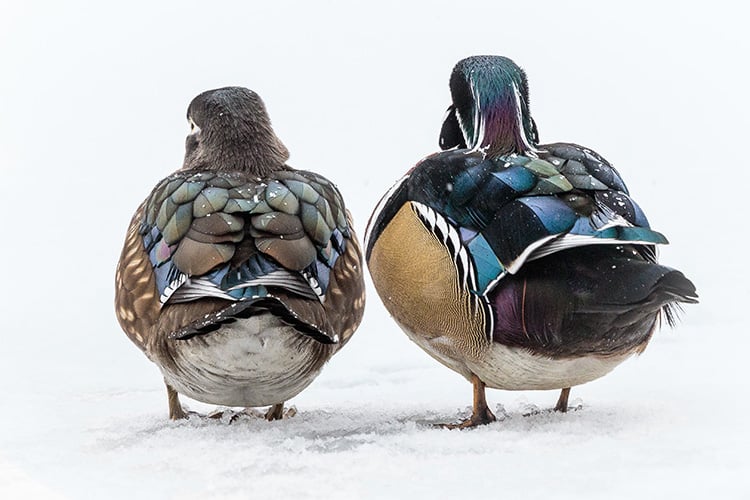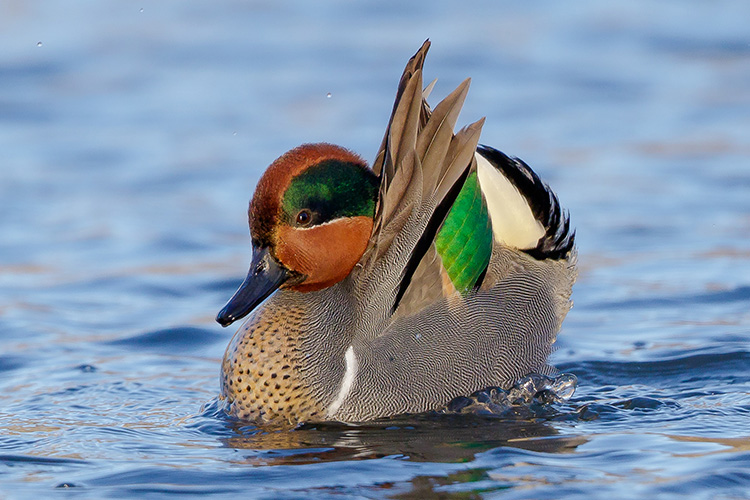Waterfowl in Winter
January 01, 2019
Waterfowl—the collective term for ducks, geese, and swans—are a diverse group of wetland birds classified in the family Anatidae.
Winter is a particularly fine season to appreciate waterfowl. In the summer, the colorful males wear a less colorful, female-like plumage called eclipse plumage. By late fall and winter, however, the majority of species return to wearing their bright and more colorful breeding plumages.
On the Water
Of the more than 25 waterfowl species that regularly spend the winter in Massachusetts, only 10 commonly nest here, and each has its own preferred type of habitat. Look for sea ducks, such as Common Eider, Harlequin Duck, three species of scoter, and Long-tailed Duck, on open saltwater in winter.
Others like the Wood Duck, Gadwall, Ring-necked Duck, Common Merganser, and Ruddy Duck stick to freshwater marshlands, ponds, or rivers wherever there is open water.
And some species, such as the Canvasback, Greater Scaup, Bufflehead, and Common Goldeneye, make themselves equally at home in either saltwater or freshwater situations.
Dinner Time
In keeping with their diversity, it is not surprising that waterfowl exhibit a number of foraging behaviors and have a variety of dietary preferences.
Sea ducks, such as eiders and scoters, obtain mussels and clams off the bottom of the ocean, while diving species, such as Long-tailed Ducks, Buffleheads, and Common Goldeneyes, prefer small crustaceans, snails, or wintering aquatic insect larvae.
Canvasbacks are largely vegetarian in the winter and seek submerged water plants such as wild celery, wigeon grass, and eelgrass, while Common and Red-breasted mergansers feed predominantly on fish that they capture by powerful underwater swimming.
Wintering freshwater waterfowl, such as American Black Ducks, Mallards, and Northern Pintails, obtain their food by tipping up in shallow water, or by grazing on succulent submerged aquatic plants, plant tubers, seeds, and small mollusks in shallow water.
Holding Court(ship)
Many waterfowl begin their courtship activities in midwinter, which means now’s the time to see some fascinating and sometimes amusing pre-breeding courtship behavior.
Such behaviors often include vigorous aerial chases, head bobbing, neck stretching, water splashing, and distinctive vocalizations.
Find expert naturalist-led winter birding trips near you
Top Winter Waterfowl Viewing Spots
To maximize your chances of seeing a variety of waterfowl in the winter and early spring, look for habitats where there is open water, either salt or fresh.
Coastal Saltwater Species
For sea ducks and other saltwater species, such as Common Eider, scoters, Long-tailed Duck, Common Goldeneye, and Red-breasted Merganser, almost any exposed ocean view offers opportunities.
- Joppa Flats Education Center in Newburyport
- Parker River Refuge on Plum Island
- Andrews Point in Rockport
- Nahant Beach
- Deer Island in Boston Harbor
- North River Wildlife Sanctuary in Marshfield
- Tidmarsh Wildlife Sanctuary in Plymouth
- Manomet Point and Plymouth Harbor in Plymouth
- East entrance to the Cape Cod Canal in Bourne
- Allens Pond Wildlife Sanctuary in South Dartmouth
- Long Pasture Wildlife Sanctuary in Barnstable
- East-facing beaches on outer Cape Cod
- Wellfleet Bay Wildlife Sanctuary in South Wellfleet
- Felix Neck Wildlife Sanctuary on Martha’s Vineyard
Inland Freshwater Species
For freshwater waterfowl viewing, look for large bodies of open water such as ponds, lakes, and rivers anywhere from Boston to the Berkshires. Any inland flooded fields, or areas where rivers are in flood, can be excellent for viewing ducks.
- Jamaica Pond in Boston
- Great Pond in Randolph
- Lake Massapoag in Sharon
- Monponsett Pond in Halifax
- All of the large ponds in Lakeville
- Framingham Reservoir in Framingham
- Wachusett Reservoir and Quabbin Reservoir in central Massachusetts
- Arcadia Wildlife Sanctuary in Easthampton and Northampton
- Barton’s Cove in Greenfield
- Lake Onota in Pittsfield
Before you head out, be sure to familiarize yourself with the common birds found in Massachusetts, including what to look for.
Upcoming Bird Programs
See MoreMonthly Bird Walks
-
Magazine Beach Park Nature Center, Cambridge
-
Saturday, April 19
8:00-10:00am
Adults
Birding Workshop: Warblers by Ear
-
Greylock Glen, Adams
-
Saturday, April 19
9:00am-12:00pm
Adults
Birding for Your Mental Health
-
Blue Hills Trailside Museum, Milton
-
Saturday, April 19
10:00-11:30am
Adults
Stay Connected
Don't miss a beat on all the ways you can get outdoors, celebrate nature, and get involved.





